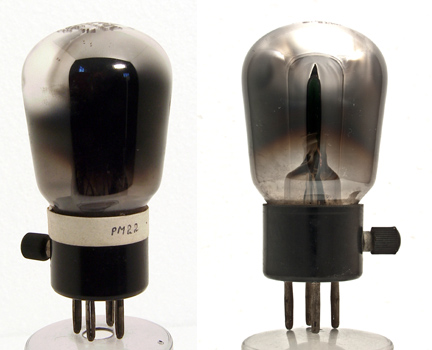|

The PM22 on the left and the PM24 on the right.
I have been carrying out some tests with the new Mullard 'Pentone' valve which is likely to be released for public. sale in the near future - possibly before you read these lines.
The valve itself is normal in appearance except that it has a terminal in the base in addition to the four round pins on the base itself.
That grid nearest the filament is the usual control grid, outside this is an auxiliary grid which is connected to the terminal on the side of the valve base, and which under working conditions is provided with a positive bias equal to that applied to the anode of the valve, while the third grid (nearest the anode) is connected internally to one of the filament pins.
High Amplification Factor
In use the valve can be plugged in to any set, its four pins in the base making contact with the usual plate, grid, and two filament sockets of the normal valve holder, while the extra terminal on the base of the valve is connected by a piece of flex to that HT+ terminal which supplies the HT+ to the anode of the valve.
The whole idea of the Pentone, which is to be marketed in two voltages (2 and 4), is to provide a very high amplification factor so that with small inputs the valve is capable of a large output.
The electrodes are arranged so that a magnification factor of 62 is obtained in the case of the 4 Volt valve and one of 82 in the case of the 2 Volt valve. The only trouble accompanying this is the fact that the impedance is also high in each case, being 28,600Ω and 62,500Ω respectively.
On test these figures were upheld within reasonable limits, and great magnification was obtained, though the question of a suitable plate circuit impedance has yet to be settled. The makers intend the Pentone to take the place of the usual last valve, but it must be realised that with the ordinary output valve an impedance of anything from 2,000 to 8,000 Ω may be used, and here the loud speaker can go reasonably well direct in the plate circuit, whereas in the case of the Pentone the impedance is 28,000 or 62,000 Ω, and then the loud speaker will obviously be of too low an impedance to be placed directly in the plate circuit if any reasonable degree of success is desired.
A special 30 to 1, or some such ratio, output transformer is really necessary.
There is another point I have found, perhaps rather expectedly, that the Pentone does not reproduce the bass notes to the same extent as the ordinary output valve of low-impedance type. It may be due to the non-matching of external impedances with that of the valve, but the fact remained. I should welcome results from readers as soon as they have had opportunities to test these new valves. In magnification they certainly do do their job.
They are not designed for heavy inputs, and so although they are to take the place of the output valve they must be used circumspectly.
A Real Saving
It must not be thought that the PM22 and PM24 are merely a substitute for the super-power valves, because the Pentones magnification powers make it such that, whereas it is now general practice to employ an LF stage between the detector valve and the output valve, the use of the Pentone in the place of this latter should enable one to dispense with the intermediate LF stage.
That is to say, that a detector and one Pentone would give, the same volume as at detector, one intermediate LF and a super-power valve. Thus a real saving in valves, in current consumption (the 4 Volt Pentone filament only takes 0.15 amp) and in HT would result. It still remains to be seen whether output circuits really suitable can be devised - suitable to such an extent that reproduction will not suffer in any degree by the substitution of multi-grid valves for those of the ordinary types.
|